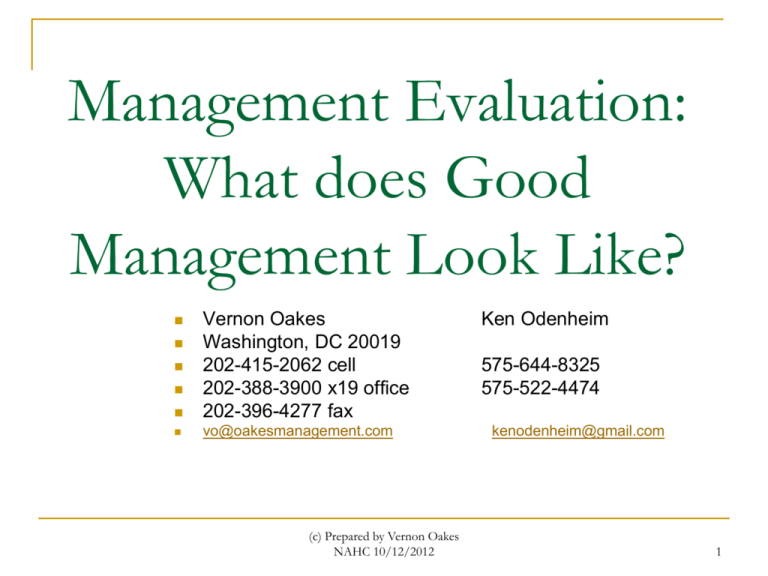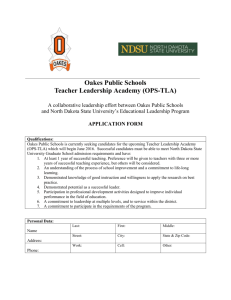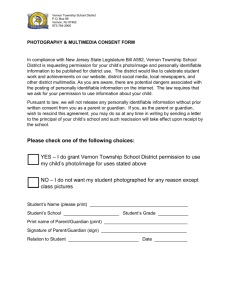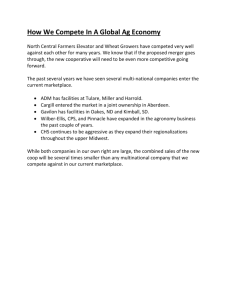DEFINITION OF EVALUATION (Webster New World Dictionary)
advertisement

Management Evaluation: What does Good Management Look Like? Vernon Oakes Washington, DC 20019 202-415-2062 cell 202-388-3900 x19 office 202-396-4277 fax vo@oakesmanagement.com (c) Prepared by Vernon Oakes NAHC 10/12/2012 Ken Odenheim 575-644-8325 575-522-4474 kenodenheim@gmail.com 1 Evaluation - Discussion Points Slide 3 Slide 4 Slide 5 Slide 6 Slide 7 Slide 8 Slide 9-10 Slide 11 Slide 12-17 Slide 18 Slide 19 Definition of Evaluation Successful Relationship Model Problem Solving Model How do you evaluate? Daily or Continuous Evaluation Praise or reprimand The Benefits of Self-Evaluation Self-Evaluation Process (Start) Board Performance Checklist Self-Evaluation Process (Finish) Summary (c) Prepared by Vernon Oakes NAHC 10/12/2012 2 Definition of Evaluation (Webster New World Dictionary) Evaluate 1. To find the value or amount of, 2. To judge or determine the worth or quality of: appraise. Why do evaluations? 1. To motivate a person to continue good behavior 2. To motivate a person to change behavior if the behavior does not get the desired results. “Feedback is the breakfast of champions”, by Tom Peters (c) Prepared by Vernon Oakes NAHC 10/12/2012 3 Successful Relationship Model INTEGRITY Authority – What power does one have to make decisions to get things done? Responsibility – What tasks, jobs does the person have to perform? Has the person agreed to do these tasks? Accountability – Who holds the person accountable? How will the person be measured? How and when will the person be evaluated? Compensation – What is the total compensation (Money, vacations, “pats on the back” or …) ? For success, all of these must be in alignment. When there is alignment, there is Integrity (c) Prepared by Vernon Oakes NAHC 10/12/2012 4 INTEGRITY Integrity is saying what you are going to do, then doing what you said. If you find that you can not do what you said, then you let the person know immediately. This is Honoring Your Word Another definition is Planning Your Work and Working Your Plan Talk the Walk and Walk the Talk (c) Prepared by Vernon Oakes NAHC 10/12/2012 5 Problem Solving Model 1. Define problem or opportunity a. b. 2. 3. 4. 5. 6. 7. Current Situation (What’s happening now?) Desired Situation (What do you want to happen, goal?) Assumptions/facts, what you think or know Alternatives, a minimum of three Analysis of Alternatives Recommendation/Decision Implementation – who, does what, when! Evaluation of person and/or project (c) Prepared by Vernon Oakes NAHC 10/12/2012 6 Using a Priority Grid By Ken Odenheim Often, one of the most difficult tasks facing co-op Boards and Committees is the selection and ranking of priorities. When structured properly, this daunting task is simplified by the use of a priority grid. A priority grid is a tool designed to make this process easier by allowing the participant to choose between two priorities at a time, ranking each choice against all priority choices. (c) Prepared by Vernon Oakes NAHC 10/12/2012 7 (c) Prepared by Vernon Oakes NAHC 10/12/2012 8 Using a Priority Grid 1. Insert the items to be prioritized, in any order in Section A. 2. Then compare two items at a time, circling the one you prefer among the two in Section B. 3. Then count the number of times each item was circled and write this down in Section C. This determines the item’s ranking; the item that is circled the most is #1, the next most circled is ranked as #2, etc. 4. It two items are circled the same number of times, look back in Section B to see when those two items were compared; give the item that you preferred an extra half point. 5. Then complete the rank order and enter the results in Section D. (c) Prepared by Vernon Oakes NAHC 10/12/2012 9 How do you evaluate? Daily or Continuously The One Minute Manager Self-Evaluation Process (Info from the National Center for Nonprofit Boards (800-883-6262) (c) Prepared by Vernon Oakes NAHC 10/12/2012 10 Daily or Continuous Evaluation The One Minute Manager i. Make sure a person knows what is expected of him/her (tasks defined, jobs described, etc.) Make sure a person can do what is expected of him/her (have the knowledge, skills, and resources to do the tasks, jobs). ii. Tell him/her when he/she does it right – praise. iii.Tell him/her when he/she does it wrong – reprimand. (c) Prepared by Vernon Oakes NAHC 10/12/2012 11 How do you do a PRAISE or REPRIMAND? 1. Go to him/her immediately, don’t wait 2. Tell him/her exactly what they did or didn’t do 3. Tell him/her how it made you feel 4. Pause so they can feel how you feel 5. Tell him/her why it is good for the community for them to continue the behavior, if praise or change behavior, if reprimand 6. Let him know that he is OK as a person 7. Shake hands or touch in an appropriate way. When it is over it is over. Possibly make notes for annual evaluation (c) Prepared by Vernon Oakes NAHC 10/12/2012 12 The Benefits of Evaluation Refresh Board’s and Management’s understanding of role and responsibilities Identify important areas of operation that need attention or improvement Measure progress toward existing plans, goals and objectives Shape the future structure and operations of the board and management (c) Prepared by Vernon Oakes NAHC 10/12/2012 13 The Benefits of Evaluation Define the criteria for effective and successful management Build trust, respect, and communication among board members and with management. Enable management to work more effectively with board as part of a team. (c) Prepared by Vernon Oakes NAHC 10/12/2012 14 Evaluation Process Assess Board Readiness Gain Board Commitment Appoint a Steering Committee Select a Facilitator Seat a Retreat Date Distribute the questionnaire and Collect Responses (c) Prepared by Vernon Oakes NAHC 10/12/2012 15 Self-Evaluation Process Analyze and interpret the Questionnaire Data Establish the Retreat Agenda Hold a Self-Assessment Retreat Implement Action Plans (c) Prepared by Vernon Oakes NAHC 10/12/2012 16 Summary An individual or a board can be motivated to positive action by providing continuous, effective feedback. If your organization is ready, then do the self-evaluation. (c) Prepared by Vernon Oakes NAHC 10/12/2012 17 Management Evaluation Checklist (This checklist was developed by the Midwest Association of Housing Cooperatives, a member of NAHC) I Management Contract Circle One 1 Does the Board have a copy of the contract and management plan? Yes NO 2 Are all Board members familiar with the provisions of the contract? Yes NO 3 Is the contract reviewed at least quarterly to insure management compliance with all provisions? Yes NO 4 Does the Board have a copy of the management's fidelity bond with the coop as additional insurer? Yes NO 5 Does the Management pay all expenses called for in the contract? Yes NO 6 Does your contract permit the Board to terminate the contract within 90 days or less? Yes NO 7 Does the contract provide a clear statement of services and fees? Yes NO 8 Is the manager on site as contracted? Yes NO 9 Is the contract individually tailored to the co-op's needs? Yes NO 10 Does the contract call for written monthly reports from managers? Yes NO 11 Does the manager have errors and omissions insurance? Yes NO (c) Prepared by Vernon Oakes NAHC 10/12/2012 18 Management Evaluation Checklist (This checklist was developed by Vernon Oakes) II Management Manages Employees Circle One 1 Does the agent hire, pay, supervise, train, evaluate and when necessary discharge the employees that work for the project? Yes NO 2 Yes NO 3 Yes NO 4 Yes NO 5 Yes NO 6 Yes NO 7 Yes NO 8 Yes NO 9 Yes NO 10 Yes NO 11 Yes NO (c) Prepared by Vernon Oakes NAHC 10/12/2012 19 Management Evaluation Checklist (This checklist was developed by the Midwest Association of Housing Cooperatives, a member of NAHC) III Management Reports Circle One 1 Are management reports up-to-date? Yes NO 2 Do the Board members receive the manager's monthly reports at least three days before meetings? Yes NO 3 Does the Board receive monthly reports on finances, vacancies, move-outs, move-ins, delinquency and maintenance? Yes NO 4 Does the Board read reports before meetings? Yes NO 5 Does the Board receive monthly reports on actions and status of Board directives? Yes NO 6 Is the manager responsible for the content of the reports? Yes NO 7 Does the report give contacts and sales of units? Yes NO 8 Does the manager make a presentation on the reports to the Board? Yes NO 9 Do Board Members understand the monthly reports? Yes NO (c) Prepared by Vernon Oakes NAHC 10/12/2012 20 Management Evaluation Checklist (This checklist was developed by the) VI Communications Circle One 1 Is the Board President the only official communicator with the manager between meetings? Yes NO 2 Do individual Board members abstain from making special requests of management? Yes NO 3 Yes NO 4 Yes NO 5 Yes NO 6 Yes NO 7 Yes NO 8 Yes NO 9 Yes NO 10 Yes NO (c) Prepared by Vernon Oakes NAHC 10/12/2012 21 Management Bonus for HUD Property Operations and Administration Description of Task 1 Management Operating Review 2 Files in order 3 Waiting List is managed to HUD's standards 4 Certifications and Recertifications 5 Monthly Reports to property and agencies 6 Collections (considering Vacancy and Deliquency) 7 Expenses Not including Capitol Improvement or Mortgage Measure Satisfactory Bonus Measure 0.10% Unsatisfactory Penalty -0.10% 97% or more of Current files are in order It is 0.05% less than 97% -0.05% 0.10% it isn't -0.10% Complete and accurate 97% of certifications Complete and accurate 95% of the time Collect 95% or Higher of Approved Rent Roll Actual Expenses less than 105% of Budget 0.10% less than 97% certifications 0.10% less than 95% of the time 0.10% Collect less than 95% of Approved Rent Roll 0.10% Actual Expenses more than 105% of Budget -0.10% (c) Prepared by Vernon Oakes NAHC 10/12/2012 -0.10% -0.10% -0.10% 22 Management Bonus for HUD Property Facilities Maintenance 8 REAC Inspection 9 Work Orders - Normal Measure Score 80 or higher 98% or more completed within 5 days Bonus Measure Penalty 0.10 score less than 80 % 0.10% 0.05 less than 98% % completed in 5 days 0.05% 10 Work Orders - Emergency 95% or more 0.05 less than 95% completed within 1 day % completed in 1 day 11 Vacant Unit Ready for Complete Turn within 7 0.10 Complete Turn in Occupancy Days % more than 7 Days (c) Prepared by Vernon Oakes NAHC 10/12/2012 0.05% 0.10% 23 Management Bonus for HUD Property Financial Planning and Analysis Measure 12 Detailed budget complete Completed with by Nov. 15, of each year Board input 13 Insurance, Reserve Completed Analysis, and Utility Review Bonus Measure Penalty 0.05% Not complete or no -0.05% board input 0.10% Not completed -0.10% Education/Training 14 Each site staff member is being certified 15 The board and members are being trained Each staff member is 0.05% Each staff member is -0.05% making progress not making progress Yes through NAHC, 0.05% No -0.05% PAHC, CAI or other 1.20% -1.20% (c) Prepared by Vernon Oakes NAHC 10/12/2012 24






